#Buller's shearwater
Text
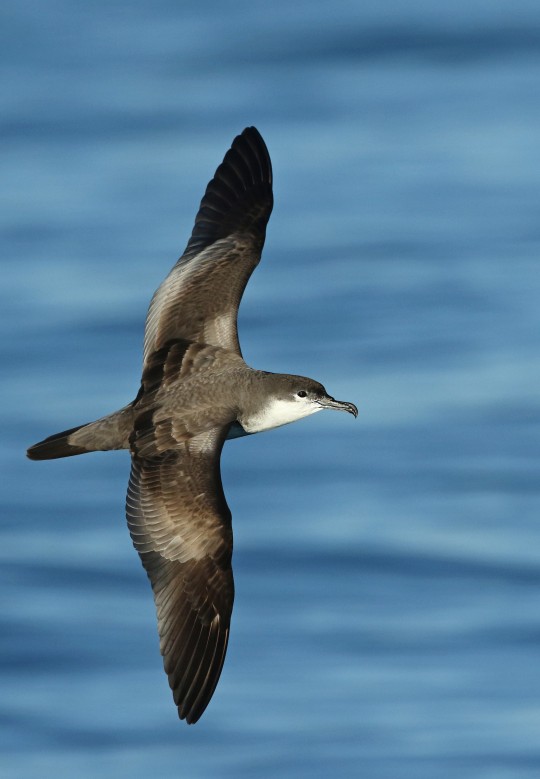
[1933/10977] Buller's shearwater - Ardenna bulleri
Order: Procellariiformes (tubenoses)
Family: Procellariidae (petrels, prions and shearwaters)
Photo credit: Luke Seitz via Macaulay Library
80 notes
·
View notes
Text
I would like to offer this resource for therians, an extensive list of all of Sir David Attenborough’s nature documentaries that are available on soap2day, and a full list of what species* they each (notably, prominently) feature the natural behaviors of, separated by episode, and omitting species that were only shown dead, juvenile or being predated on. This took me a while (I have been working on it since Prehistoric Planet’s release) because I did in fact have to watch every single series in full in order to list all the species and the episodes are around 50 minutes long, but enjoy.
Long post ahead:
Most of these shows have closed captioning, which is why I’ve picked soap2day. Planet Earth is the only one that doesn’t. I did not include Dynasties and Dynasties II because each episode only features one species.
Thank you to Birch (@ambiguousmutt) for his help (he watched about half of the episodes) so I didn’t have to do it individually. Credit goes to him as well.
*Sometimes Attenborough doesn’t say the specific species and I was too busy trying to get through the episodes to identify it. In those cases I just put the most specific name I could.
Planet Earth
Episode one (From Pole to Pole): emperor penguin, polar bear, caribou, arctic grey wolf, Amur leopard, six-plumed bird-of-paradise, superb bird-of-paradise, great white shark, African elephant, African buffalo, lechwe, baboon, African wild dog
Episode two (Mountains): gelada, walia ibex, Ethiopian wolf, guanaco, cougar, grizzly bear, markhor, snow leopard, golden eagle, grey wolf, panda, golden snub-nosed monkey, red panda, demoiselle crane
Episode three (Fresh Water): giant salamander, grizzly bear, smooth-coated otter, Nile crocodile, dolphin fish, midge, Amazon river dolphin, dorado, piranha, spectacled caiman, crab-eating macaque, snow goose
Episode four (Caves): wrinkle-lipped free-tailed bat, cockroach, bat hawk, cave swiftlet, yellow-red rat snake, Texas blind salamander
Episode five (Deserts): Bactrian camel, dromedary camel, red kangaroo, fennec fox, guanaco, long-nosed bat, Nubian ibex, flat lizard, lion, African elephant, locust
Episode six (Ice Worlds): snow petrel, Antarctic petrel, south polar skua, humpback whale, emperor penguin, eider, muskox, arctic grey wolf, polar bear, little auk, arctic fox
Episode seven (Great Plains): Mongolian gazelle, red-billed quelea, wildebeest, snow goose, arctic fox, arctic grey wolf, bison, wild ass, Tibetan fox, pygmy hog, African elephant, lion, baboon
Episode eight (Jungles): magnificent bird-of-paradise, spider monkey, howler monkey, siamang gibbon, gliding tree frog, colugo, red crab spider, African elephant, chimpanzee
Episode nine (The Shallow Seas): humpback whale, multiple corals, banded sea krait, trevally, dugong, bottlenose dolphin, Socotra cormorant, salp, comb jelly, sea lion, dusky dolphin, sea urchin, sunflower starfish, short-tailed stingray, great white shark, king penguin, fur seal
Episode ten (Seasonal Forests): Eurasian lynx, moose, crossbill, wolverine, western capercaillie, pine marten, great grey owl, pudu, kodkod, mandarin duck, cicada, red deer, Amur leopard, tiger, mouse lemur
Episode eleven (Ocean Deep): whale shark, oceanic whitetip shark, common dolphin, Cory's shearwater, manta ray, sea spider, vampire squid, spider crab, unnamed deep sea eel, giant isopod, chambered nautilus, Pacific spotted dolphin, mola mola, frigatebird, sailfish, blue whale
Planet Earth II
Episode one (Islands): pygmy three-toed sloth, Komodo dragon, sifaka, marine iguana, Galapagos racer, Buller's albatross, fairy tern, Christmas Island red crab, yellow crazy ant, chinstrap penguin
Episode two (Mountains): Nubian ibex, red fox, golden eagle, grizzly bear, bobcat, flamingo, mountain viscacha rat, snow leopard
Episode three (Jungles): spider monkey, flying lizard, sword-billed hummingbird, river dolphin, jaguar, glass frog, paper wasp, click beetle, red bird of paradise, Wilson's bird of paradise, indri
Episode four (Deserts): lion, Harris's hawk, shrike, locust, sand grouse, pale chanting goshawk, feral mustang, golden mole, desert long-eared bat, darkling beetle, Namaqua chameleon
Episode five (Grasslands): saiga antelope, lion, harvest mouse, carmine bee-eater, Kori bustard, African elephant, serval, Jackson's widowbird, grasscutter ant, compass termite, giant anteater, bison, red fox, arctic grey wolf
Episode six (Cities): langur, peregrine falcon, leopard, European starling, great bowerbird, raccoon, rhesus macaque, spotted hyena, wels catfish
Our Planet
Episode one (One Planet): lesser flamingo, orchid bee, golden-collared manakin, red-capped manakin, blue manakin, cormorant, booby, common dolphin, shearwater, African wild dog, timber wolf
Episode two (Frozen Worlds): gentoo penguin, wandering albatross, narwhal, Pacific walrus, humpback whale, orca, leopard seal, polar bear
Episode three (Jungles): lowland gorilla, forest elephant, black sicklebill, twelve-wired bird-of-paradise, western parotia, mountain treeshrew, Philippine eagle, black spider monkey, leafcutter ant, Sumatra orangutan, velvet worm
Episode four (Coastal Seas): northern fur seal, compass jellyfish, giant trevally, mobula ray, Atlantic stingray, bottlenose dolphin, grey reef shark, whitetip reef shark, sea otter, California sheephead wrasse, Steller's sea lion, bald eagle, humpback whale, Guanay cormorant, Inca tern, Peruvian booby, South American sea lion
Episode five (From Deserts to Grasslands): Socotran cormorant, Arabian leopard, Arabian oryx, African elephant, cheetah, bison, Alcon blue butterfly, saiga, Przewalski's wild horse, tiger
Episode six (The High Seas): blue whale, spinner dolphin, mobula ray, oarfish, anglerfish, bristle worm, giant petrel, black-browed albatross, wandering albatross, bluefin tuna, sea lion, humpback whale
Episode seven (Fresh Water): Australian pelican, torrent duck, grizzly bear, manatee, giant mayfly, common kingfisher, osprey, jaguar, callipterus cichlid, Siamese fighting fish, hippopotamus, lion, African elephant, sandhill crane
Episode eight (Forests): Siberian tiger, bald eagle, rough-skinned newt, great hornbill, African elephant, African wild dog, fossa, gray mouse lemur
A Perfect Planet
Episode one (Volcano): lesser flamingo, marabou stork, Galápagos land iguana, vampire ground finch, Aldabra giant tortoise, North American river otter, coyote, Kamchatka brown bear, wildebeest
Episode two (The Sun): yellow-cheeked gibbon, fig wasp, arctic grey wolf, wood frog, garter snake, arctic fox, Saharan silver ant, golden snub-nosed monkey, sooty shearwater, humpback whales
Episode three (Weather): straw-colored fruit bat, fire ant, Amazonian giant river turtle, desert rain frog, Bactrian camel, Christmas Island red crab, carmine bee-eater, Nile crocodile, African fish eagle, hippopotamus
Episode four (Oceans): common dolphin, marine iguana, flightless cormorant, flamboyant cuttlefish, eider, bottlenose dolphin, lemon shark, manta ray, blacktip reef shark, trevally, rockhopper pengin, Eden's whale
Episode five (Humans): none
Life
Episode one (Challenges of Life): bottlenose dolphins, cheetah, panther chameleon, orca, brown-tufted capuchin, stalk-eyed fly, hippopotamus, Clark's grebe, giant Pacific octopus, strawberry poison-dart frog, leopard seal, orangutan
Episode two (Reptiles and Amphibians): pebble toad, caiman, basilisk, Brazilian pygmy gecko, panther chameleon, Namaqua chameleon, red-sided garter snake, collared iguana, hog-nosed snake, horned lizard, sea krait, African bullfrog, Komodo dragon
Episode three (Mammals): Weddell seal, elephant shrew, aye-aye, caribou, straw-colored fruit bat, lion, spotted hyena, polar bear, brown-nosed coati, meerkat, African elephant, humpback whale
Episode four (Fish): sailfish, flying fish, weedy sea dragon, convict fish, sarcastic fringehead, mudskipper, Hawaiian freshwater goby, hippopotamus, barbel, silvertip shark, clownfish, sea lion, ragged tooth shark, multiple snapper, whale shark
Episode five (Birds): spatuletail hummingbird, lammergeier, red-billed tropicbird, magnificent frigatebird, red knot, horseshoe crab, lesser flamingo, chinstrap penguin, great white pelican, Clark’s grebe, sage grouse, Vogelkop bowerbird
Episode six (Insects): Darwin’s beetle, unnamed damselfly, monarch butterfly, alkali fly, Wilson’s phalarope, oogpister beetle, mongoose, bombardier beetle, honey bee, black bear, Japanese red bug, Dawson’s bee, grass cutter ant
Episode seven (Hunters and Hunted): ibex, short-tailed stoat, brown bear, Ethiopian wolf, California ground squirrel, star-nosed mole, cheetah, red fox, greater bulldog bat, bottlenose dolphin, Bengal tiger, rattlesnake, orca
Episode eight (Creatures of the Deep): Pompeii worm, Humboldt squid, nemertean worm, moon jelly, fried egg jellyfish, spider crab, stingray, cuttlefish, giant Pacific octopus, sunflower sea star, king crab, cleaner shrimp
Episode nine (Plants): monarch butterfly, purple-throated carib hummingbird
Episode ten (Primates): Hamadryas baboon, Japanese macaque, lowland gorilla, spectral tarsier, phayre's leaf monkey, ring-tailed lemur, Sumatra orangutan, chacma baboon, white-faced capuchin, brown-tufted capuchin, western chimpanzee
Blue Planet II
Episode one (One Ocean): bottlenose dolphin, tuskfish, tern, giant trevally, mobula ray, false killer whale, Asian sheepshead wrasse, orca, humpback whale, walrus
Episode two (The Deep): sea toad, Venus’ flower basket, unnamed shrimp, ethereal snailfish, cock-eyed squid, pyrosome, barrel-eyed fish, unnamed siphonophore, yeti crab, Humboldt squid, fangtooth fish, sixgill shark, scabbardfish, zombie worm
Episode three (Coral Reefs): broadclub cuttlefish, coral grouper, day octopus, multiple corals, green turtle, bottlenose dolphin, manta ray, bobbit worm, saddleback clownfish, marbled grouper, grey reef shark
Episode four (Big Blue): spinner dolphin, yellowfin tuna, mobula ray, sailfish, sperm whale, sea turtle, blue shark, great white shark, multiple jellyfish, Portuguese man o' war, whale shark, wandering albatross, shortfin pilot whale
Episode five (Green Seas): Garibaldi, Australian giant cuttlefish, weedy seadragon, common octopus, pyjama shark, sea otter, tiger shark, smooth stingray, zebra mantis shrimp, common dolphin, humpback whale
Episode six (Coasts): Pacific leaping blenny, king penguin, southern elephant seal, Sally Lightfoot crab, Galápagos sea lion, ochre starfish, clingfish, chain moray eel, Atlantic puffin, arctic skua
Episode seven (Our Blue Planet): none
Prehistoric Planet
Episode one (Coasts): Tyrannosaurus rex, Tethydraco, Phosphatodraco, Tuarangisaurus, Mosasaurus hoffmannii, pycnodont fish, ammonites, Kaikaifilu
Episode two (Deserts): Dreadnoughtus, Tarbosaurus, Velociraptor, Mononykus, Barbaridactylus, Secernosaurus
Episode three (Freshwater): Velociraptor, Tyrannosaurus rex, Deinocheirus, Quetzalcoatlus, Masiakasaurus, Beelzebufo, elasmosaur
Episode four (Ice Worlds): dromaeosaur, hadrosaur, Ornithomimus, Olorotitan, troodontid, Antarctopelta, Pachyrhinosaurus, Nanuqsaurus
Episode five (Forests): Austroposeidon, Triceratops, Carnotaurus, Qianzhousaurus, Edmontosaurus, Atrociraptor, Anodontosaurus, Therizinosaurus, Telmatosaurus, Hatzegopteryx
The Hunt
Episode one (The Hardest Challenge): African leopard, African wild dog, Parson’s chameleon, nose-horned chameleon, African mantis, Darwin’s bark spider, Nile crocodile, Amur falcon, orca, cheetah
Episode two (Arctic): polar bear, arctic grey wolf, arctic fox, glaucous gull
Episode three (Forests): tiger, American marten, sparrow hawk, Portia spider, tarsier, harpy eagle, chimpanzee, army ant
Episode four (Oceans): blue whale, frigatebird, dorado, sargassum fish, spinner dolphin, Beroe ovata, Chiroteuthis, lionfish, black-browed albatross, sea lion, tuna, copper shark, common dolphin, Bryde's whale
Episode five (Plains): cheetah, caracal, honey badger, termite, bald eagle, lion, Ethiopian wolf, hotrod ant, spoor spider
Episode six (Coasts): bottlenose dolphin, algae octopus, sand bubbler crab, long-tailed macaque, marine otter, grizzly bear, grey wolf, peregrine falcon, orca, humpback whale
Episode seven (Conservation): none
Life In Colour
Episode one (Seeing In Color): Indian peafowl, mandrill, Costa’s hummingbird, magnificent bird-of-paradise, blue moon butterfly, fiddler crab, mantis shrimp, flamingo, poison dart frog
Episode two (Hiding In Color): Bengal tiger, langur, ptarmigan, crab spider, zebra, Cuban painted snail, blue-striped fangblenny, common waxbill, pin-tailed wydah, Augrabies flat lizard
Frozen Planet II
Episode one (Frozen Worlds): emperor penguin, orca, Pallas’s cat, Siberian tiger, grizzly bear, hooded seal, polar bear
Episode two (Frozen Ocean): polar bear, beluga, harp seal, skeleton shrimp, crested auklet, orca
Episode three (Frozen Peaks): high-casqued chameleon, japanese macaque, kea, andean flamingo, giant panda, golden eagle, andean mountain lion
Episode four (Frozen South): king penguin, Antipodean wandering albatross, blue whale, Weddell seal, chinstrap penguin, snow petrel, leopard seal, orca
Episode five (Frozen Lands): grey wolf, arctic fox, Amur leopard, Siberian tiger, painted turtl, Lapland bumblebee, snowy owl, caribou, grizzly bear
Episode six (Our Frozen Planet): none
Africa
Episode one (Kalahari): fork-tailed drongo, ostrich, black rhinoceros, Angolan giraffe, African leopard, armored ground cricket, spider wasp
Episode two (Savannah): Agama lizard, shoebill, bee-eaters and rollers, lesser flamingo, African elephant, crowned eagle, African fish eagle, martial eagle
Episode three (Congo): chimpanzee, central African rock python, Angola banana frog, African skimmer, rockfowl, African elephant
Episode four (Cape): emperor swallowtail, giant kingfish, African penguin, monkey beetle, springbok, yellow-billed kite, pied crow, ghost crab, vundu catfish, Nile crocodile, Bryde’s whale, great white shark, common dolphin
Episode five (Sahara): Grevy’s zebra, naked mole rat, barn swallow, Dromedary camel, dung beetle, crocodile, western yellow wagtail, Saharan silver ant
Episode six (The Future): none
528 notes
·
View notes
Photo

January 15, 2020 - Buller's Shearwater, New Zealand Shearwater, Grey-backed Shearwater, or Rako (Ardenna bulleri)
Found in the temperate Pacific Ocean, these shearwaters breed on the Poor Knights Islands off the North Island of New Zealand. They eat fish, crustaceans, and squid, capturing prey at or near the water’s surface in flight or while swimming. Adults arrive at their breeding colonies in September and chicks leave in May. Pairs dig burrows together under trees or rocks, lining the nests with leaves, twigs, and pebbles. Both parents incubate the single egg and feed the chick. They are classified as Vulnerable by the IUCN because of their small breeding range and face threats from fishing and climate change.
#buller's shearwater#shearwater#new zealand shearwater#ardenna bulleri#bird#birds#illustration#art#water#birblr art
91 notes
·
View notes
Text
i always knew the ebird discussion group was going to absolutely tear itself apart in some vicious spat of interpersonal drama
but i did not expect “misidentified buller’s shearwater” to be the inciting incident
#birding#the internet troll in me wants to make some condescending remark#but. pelagic birds. i do not know pelagic birds#the one time i went on a pelagic trip i vomited for eight hours straight#sorry albatrosses i'm sure you're cool but i will just have to accept never seeing you again
4 notes
·
View notes
Photo
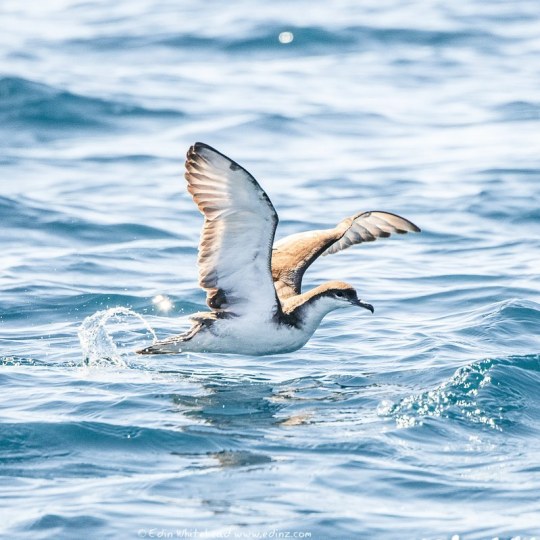
I’m really looking forward to getting back out on the water again! The rako will be leaving for their migration around the Pacific, but there’ll still be plenty of birds to see! Buller’s shearwater, 2019 #birdventurenz #seabird #shearwater #birdventure #birdsofaotearoa #nz_birds #wanderer #wildernessculture #ocean #conservationphotography #nikonnz #nikond500 #your_best_birds #eye_spy_birds #nuts_about_birds #raw_birds #birdsofinstagram #bird_brilliance #nzfinds #newzealand #aotearoa #bird_lovers_daily #bird_captures #bird_lovers #birds_adored #discover_earth https://www.instagram.com/p/CAEDy5OHzpm/?igshid=6zrypeh2071a
#birdventurenz#seabird#shearwater#birdventure#birdsofaotearoa#nz_birds#wanderer#wildernessculture#ocean#conservationphotography#nikonnz#nikond500#your_best_birds#eye_spy_birds#nuts_about_birds#raw_birds#birdsofinstagram#bird_brilliance#nzfinds#newzealand#aotearoa#bird_lovers_daily#bird_captures#bird_lovers#birds_adored#discover_earth
8 notes
·
View notes
Photo
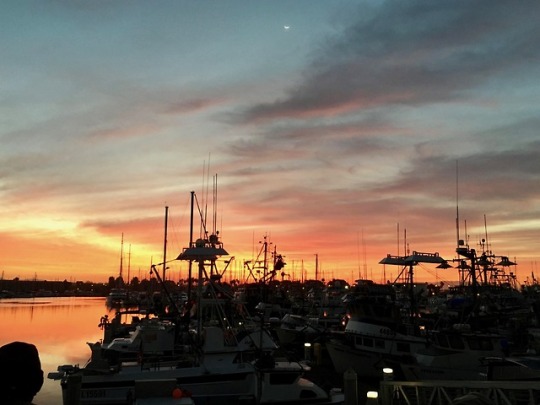
October 6 Pelagic
I went on what will probably end up being my last-of-the-year pelagic birding trip out of Ventura Harbor last weekend. The sunrise was pretty. And the birds! The official lists are still being tabulated, but it looks good for 6 new county-year birds for me. It gets tricky because we were passing back and forth through Ventura and Santa Barbara County waters – and actually a tiny bit of LA County waters as well. Because of my county year list obsession I was more excited about the Santa Barbara birds than the Ventura birds. But they were all great.
My sister and brother-in-law came along and it was fun to share the obsession with them. M’Liz volunteers with the American Cetacean Society’s gray whale census, so she’s all about the marine mammals; her favorite part of the trip was when we cruised alongside a humpacked whale that rewarded us with a full-on out-of-the-water breach. Hugh Ranson was one of the people who got a photo of the breach in-progress.
I’ll talk about the new county year birds I saw after a cut to preserve your dash.
Note: Except as indicated, the photos below aren’t by me and don’t show the actual birds I saw. They’re photos I googled up that generous people have shared under a Creative Commons license.
#309: Pomarine Jaeger (Stercorarius pomarinus)
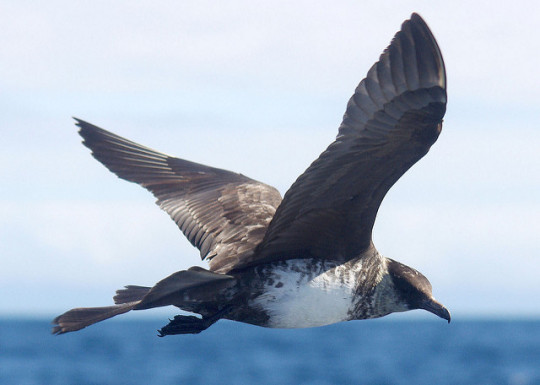
Photo by Martyne Reesman, Oregon Department of Fish and Wildlife
We saw several “poms” as we were heading out past Anacapa Island, and kept seeing them as we headed south into the “donut hole” (the circle of ocean around Santa Barbara Island that has been deemed part of Santa Barbara County for bird-listing purposes). One of the birds even had the breeding-plumage “spoons” (long central tail feathers with a twist at the end) that you can see in this photo. I’ve always wanted to see those!
#310: Craveri’s Murrelet (Synthliboramphus craveri)
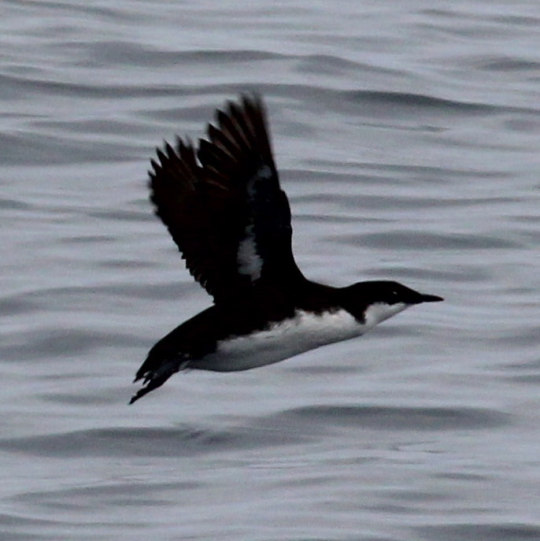
Photo by Tom Benson
We saw (and heard, one time) a few pairs of these as we approached Santa Barbara Island. Later, on the trip home, we saw a few more pairs, then one trio that I assume was mom, dad, and a chick. They were all adorable.
#311: Least Storm-Petrel (Oceanodroma microsoma)

Photo by Alan Schmierer
This is a species that I saw, technically, but would not have been able to identify from the brief look I got if it weren’t for a boatload of experts shouting, “Least Storm-Petrel!” But with the benefit of their input I did notice that this storm-petrel was super tiny compared to the Black and Ashy Storm-Petrels we’d been seeing.
#312: Blue-footed Booby (Sula nebouxii)
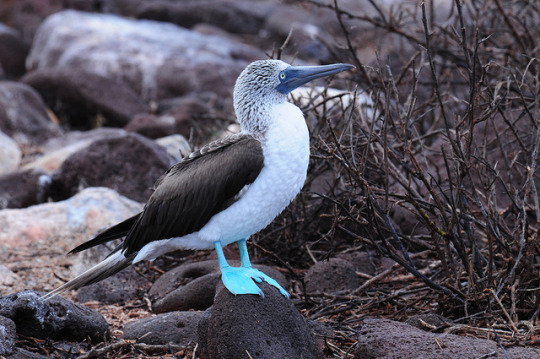
Photo by Vince Smith
This was a biggee for me. I’ve always wanted to see one, and I knew one had been seen on the previous Island Packers pelagic trip (which I didn’t go on). Then one had been seen just a few days before our trip, hanging out at Santa Barbara Island with the big group of Brown Boobies that nested there this year, so we were hoping it would still be there. And… it was!
Hugh’s photo of the bird we saw is here. Here’s a shot from my phone of the upper deck after the excitement had started to wear off:

The Blue-footed Booby is actually in the shot; here it is cropped and arrowed:
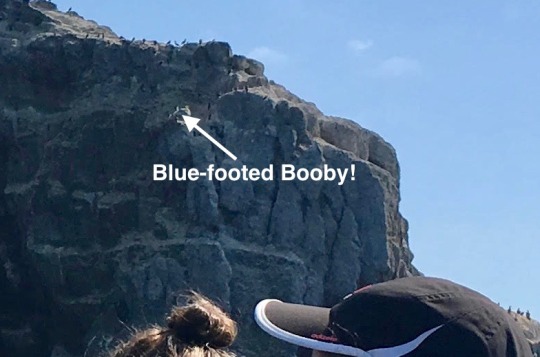
Those other specks on the cliff are mostly Brown Boobies. It was a very booby day. 🙂
#313: Buller’s Shearwater (Puffinus bulleri)
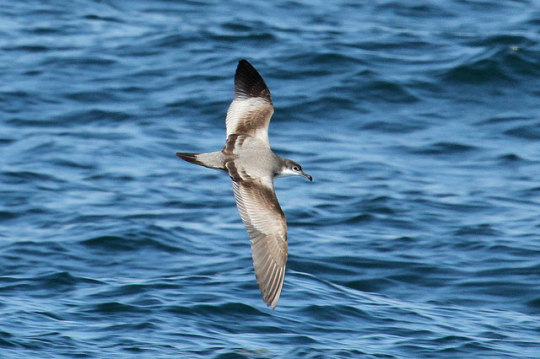
Photo by Jamie Chavez
We saw one of these mixed in with the thousands of Black-vented Shearwaters and the few dozen Pink-footed Shearwaters we steamed through in Ventura County waters, so I was primed and on the lookout for another near Santa Barbara Island. No more showed up, though, and I was thinking I wouldn’t get to add one to the county list, when bam! One showed up right next to the boat, zipping by under the bow and giving a beautiful view of that “M” pattern on its upper wings and back. Yay!
These birds are amazing. They breed in New Zealand, then spend the year doing a huge clockwise circle around the Pacific Ocean. Dave Pereksta, the birder who organized this trip, said he thinks they’re the prettiest of the shearwaters. I think he’s right.
#314: Sabine’s Gull (Xema sabini)
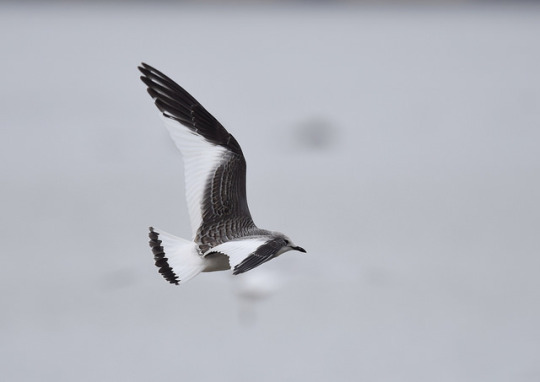
Photo by Andy Reago & Chrissy McClarren
As we headed back toward the harbor I was happy with the birds I’d seen, and starting to settle into that tired-and-sitting-and-comparing-notes phase that all pelagic trips seem to end on, when the boat slowed unexpectedly. A kelp paddy to starboard had some terns on it… Common Terns, it turns out, which are great birds, though a species I already had for the county year list. But mixed in with them were two Sabine’s Gulls! 😀
Booby addendum:
I’m burying the lead, but the big news from the trip was the boobies: We saw all five booby species in a single day, which Dave Pereksta believes had not been done before in the ABA area:
A Masked Booby (my first ever) on Anacapa Island (Ventura County, alas)
A Red-footed Booby (also my first ever) that flew alongside the boat as we steamed south (also in Ventura County)
The aforementioned Brown Boobies on Santa Barbara Island
The Blue-footed Booby on Santa Barbara Island
A Nazca Booby that we chased down in a big group of shearwaters southeast of Santa Barbara Island (a great bird, and in the right county, but a species I already saw on a previous trip)
7 notes
·
View notes
Photo
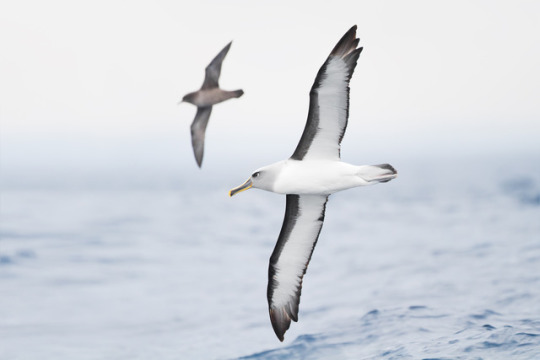
Wikipedia picture of the day on January 8, 2018:
Buller's Albatross (Thalassarche bulleri) with a Short-tailed Shearwater (Ardenna tenuirostris) behind, East of the Tasman Peninsula, Tasmania, Australia.
Learn more.
2 notes
·
View notes
Photo

I love #Tshirt. Wikipedia #picoftheday on January 8, 2018:
Buller's Albatross (Thalassarche bulleri) with a Short-tailed Shearwater (Ardenna tenuirostris) behind, East of the Tasman Peninsula, Tasmania, Australia.
Learn more.
1 note
·
View note
Text
Blialia Species and Appearance
The species living in Blialia are Angelics, Mountain Trolls, Space Beings, Werebeasts with the ability to fly, and Nature Spirits.
Blialian species have a few features typical to them. They all have what our world calls distinctly asian features.
Angelics in Blialia are small for their species, being generally two thirds the average height of the species. Common types of wings are swans, cranes, ostriches, red-throated and yellow billed loons, black-necked grebe, laysan albatross, cape and tahiti petrel, buller’s and manx shearwater, matsudaira's storm petrel, red-billed tropicbird, red-footed bobby, little black cormorant, Indian cormorant, oriental darter, Christmas frigatebird, Chinese pond heron, cattle egret, cinnamon bittern, waldrapp, flamingo, crested hawk, bat hawk, red kite, lammergeier, spotted harrier, shikra, tawny ang golden eagle, Blyth's hawk-eagle, pied falconet, merlin, gyrfalcon, rock ptarmigan, pin-tailed parrotfinch, crimson sunbird, hummingbird, various parrots, birds of paradise, and various other birds found in our worlds Asia.
Blialian mountain trolls only reach 270 cm at their tallest if from Blialia, with stone-like grey skin, moss-like hair on heads, backs, chest, and arms, and long mossy-haired tails, normally in light green. They have no tusks or horns.
Blialian space beings tend to be small, normally between the sizes of a mountain troll child and the smallest Angelics, and their shapes tend to feel like the sharp edges of blades, and tends to have bird-like wings rather than the more insectoid favored by those in Shaeq Chor.
Blialian werebeasts tend to be a bit shorter than average human size, and have very predatory yellow eyes, as well as hair in browns and reds. They are only avian werebeasts living in Blialia.
1 note
·
View note
Photo

Wikipedia picture of the day on January 8, 2018:
Buller's Albatross (Thalassarche bulleri) with a Short-tailed Shearwater (Ardenna tenuirostris) behind, East of the Tasman Peninsula, Tasmania, Australia.
Learn more.
0 notes
Photo

Wikipedia picture of the day on January 8, 2018: Buller's Albatross (Thalassarche bulleri) with a Short-tailed Shearwater (Ardenna tenuirostris) behind, East of the Tasman Peninsula, Tasmania, Australia.
0 notes
Text
Audio: Seabird secrets revealed by bioacoustics in New Zealand
http://bit.ly/2rbMwEY
On today’s episode: the sounds of Buller’s shearwaters in New Zealand’s Poor Knights Islands. Listen here: Our guest today is Megan Friesen, a behavioral ecologist who is currently working with the Northern New Zealand Seabird Trust to examine the breeding behavior of a Pacific seabird species called Buller’s shearwater. Also known as the New Zealand shearwater, the seabird breeds predominantly on Tawhiti Rahi and Aorangi, the main islands of the Poor Knights Islands, which lie off of northern New Zealand. In this Field Notes segment, Friesen (who is also Conservation Manager for Seattle Audubon) explains why bioacoustics is so important to the research she is doing with the Northern New Zealand Seabird Trust, and plays recordings of the birds from both of the islands where it breeds. Here’s this episode’s top news: Scientists stumble upon hundreds of octopus moms in the deep sea Suspected poisoning takes down 11 lions in Uganda park ‘Boom and bust’ cycle of deep-sea trawling unsustainable, study finds Half a ton of pangolin scales seized on the way to Asia from Benin New species of ‘exploding ant’ discovered in Borneo You can subscribe to the Mongabay Newscast on Android, Google Play, iTunes, Stitcher, TuneIn, or RSS. If you enjoy the Mongabay Newscast, we ask that you please consider becoming a monthly sponsor via our Patreon page, at patreon.com/mongabay. Just a dollar per month will really help us offset the production costs and hosting fees, so if you’re a fan of our audio reports from nature’s frontline,…
0 notes
Photo
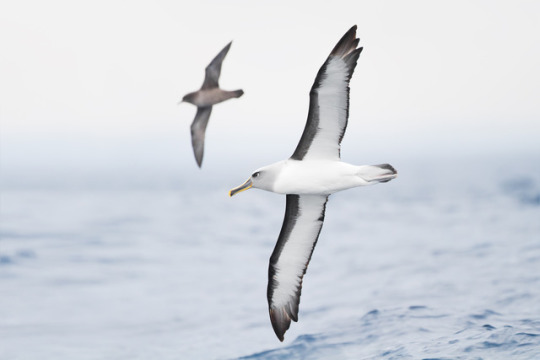
Wikipedia picture of the day on January 8, 2018:
Buller's Albatross (Thalassarche bulleri) with a Short-tailed Shearwater (Ardenna tenuirostris) behind, East of the Tasman Peninsula, Tasmania, Australia.
Learn more.
0 notes
Photo
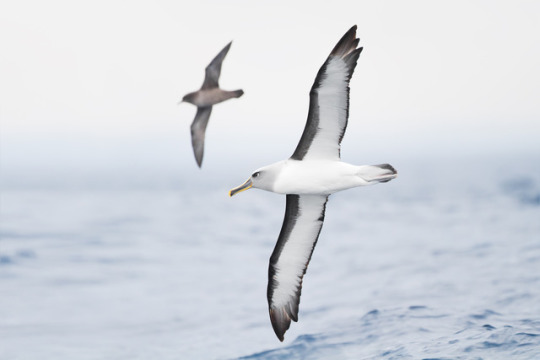
Wikipedia picture of the day on January 8, 2018: Buller's Albatross (Thalassarche bulleri) with a Short-tailed Shearwater (Ardenna tenuirostris) behind, East of the Tasman Peninsula, Tasmania, Australia. http://bit.ly/2m42yyj
0 notes
Photo

In Northern New Zealand we have 28 species of seabird - which is a huge number! We also have 5 species that are endemic - they breed in this region and nowhere else in the world, like this rako /Buller’s shearwater. ⠀ ⠀ Aotearoa New Zealand has more seabird species than all of our land birds and water birds combined. We have more native and endemic seabirds than any other country in the world, and we also regularly see migrant seabirds that come to forage in our region during their non-breeding seasons. ⠀ ⠀ But what are we doing to protect them? Surprisingly little, compared to our land birds. Seabirds face threats at sea such as fisheries and plastic pollution, but also on land such as introduced predators and light pollution. We need to start having serious conversations about protecting this important part of our native biodiversity, restoring their habitats so they can be resilient to other threats such as climate change. ⠀ ⠀ ⠀ #seabirdscience #bird_lovers_daily #conservationphotographer #plasticpollution #birds #seabird #seabirdstory #conservation #conservationphotography #shearwater #theseabirdscry #best_bird_shots #you_best_birds #birds_brilliance #birds_adored #bird_extreme #bird_captures #nuts_about_birds #womeninstem #aotearoa #newzealand #nzbirds #nikonnz #nikon @docgovtnz @forestandbird https://www.instagram.com/p/ByYY0D6ARTt/?igshid=ssrw9q9yw84x
#seabirdscience#bird_lovers_daily#conservationphotographer#plasticpollution#birds#seabird#seabirdstory#conservation#conservationphotography#shearwater#theseabirdscry#best_bird_shots#you_best_birds#birds_brilliance#birds_adored#bird_extreme#bird_captures#nuts_about_birds#womeninstem#aotearoa#newzealand#nzbirds#nikonnz#nikon
13 notes
·
View notes
Photo

Cool photo. Buller's Albatross (Thalassarche bulleri) with a Short-tailed Shearwater (Ardenna tenuirostris) behind, East of the Tasman Peninsula, Tasmania, Australia.
0 notes